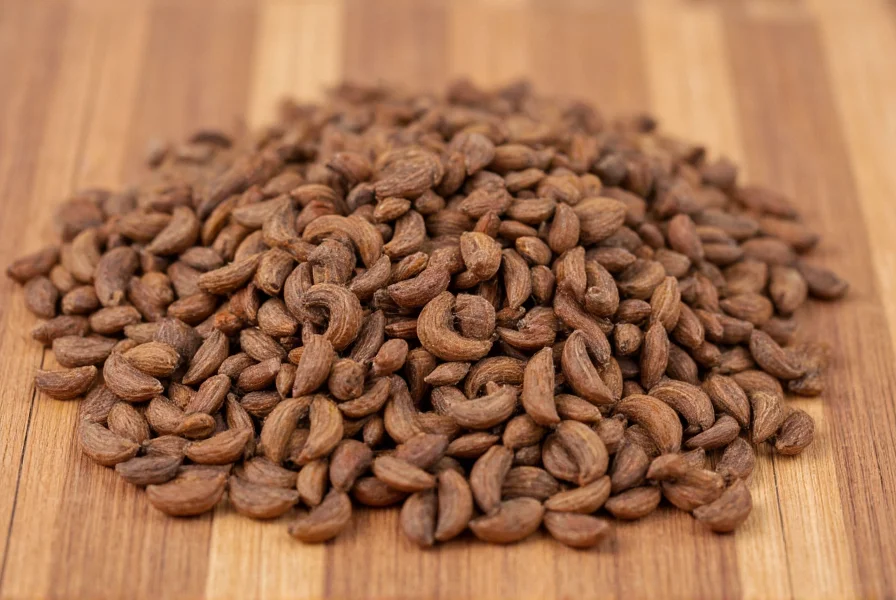Cumin has been cultivated for over 5,000 years, with historical evidence of its use dating back to ancient Egypt and the Indus Valley civilization. This versatile spice appears in two primary forms: whole seeds and ground powder, each offering distinct culinary applications and flavor profiles.
Botanical Characteristics and Varieties
Cumin belongs to the same plant family as parsley, carrots, and dill. The plant grows to about 30-50 cm tall and produces small white or pink flowers. The seeds develop in pods and are harvested when they turn brown but before they split open.
Several varieties exist worldwide:
| Variety | Origin | Characteristics |
|---|---|---|
| Indian Cumin | India | Stronger aroma, darker color, more intense flavor |
| Middle Eastern Cumin | Iran, Syria | Milder, slightly sweeter profile |
| Mexican Cumin | Mexico | Often toasted, deeper earthy notes |
| White Cumin | Mediterranean | Milder flavor, sometimes called "false cumin" |

Culinary Applications Across Global Cuisines
Cumin serves as a foundational spice in numerous culinary traditions. In Indian cooking, it's essential in curry blends, dals, and rice dishes. Mexican cuisine relies on cumin for authentic chili, tacos, and enchilada sauces. Middle Eastern recipes feature cumin in falafel, hummus, and various meat rubs.
Professional chefs often toast whole cumin seeds before grinding them to enhance their aromatic compounds. This simple technique releases volatile oils that intensify the spice's characteristic warm, slightly peppery flavor with subtle citrus undertones.
Nutritional Profile and Health Considerations
Is cumin healthy? Research indicates cumin contains several beneficial compounds. A single tablespoon (6g) of ground cumin provides:
- Approximately 22 calories
- 1.4g of dietary fiber
- Significant amounts of iron (23% of daily value)
- Moderate calcium and magnesium
- Antioxidants including terpenes, phenols, and flavonoids
Studies suggest cumin may support digestion, help regulate blood sugar, and possess anti-inflammatory properties. However, these potential benefits require further clinical research to confirm efficacy at typical culinary consumption levels.
Is Cumin Gluten Free and Safe for Special Diets?
Yes, pure cumin in its natural form is naturally gluten-free, making it suitable for those with celiac disease or gluten sensitivity. However, cross-contamination can occur during processing, so individuals with severe sensitivities should seek certified gluten-free products.
Is cumin safe during pregnancy? While culinary amounts are generally considered safe, medicinal quantities should be avoided as high doses may stimulate the uterus. Always consult with a healthcare provider regarding dietary changes during pregnancy.
Storage and Usage Tips
To maximize shelf life and flavor retention:
- Store whole cumin seeds in an airtight container away from light and heat
- Whole seeds maintain potency for 3-4 years, while ground cumin lasts 6-12 months
- Toast seeds in a dry skillet over medium heat for 1-2 minutes until fragrant before grinding
- Add ground cumin early in cooking to allow flavors to meld, while whole seeds can be added at various stages

Common Substitutes and Misconceptions
Is cumin the same as caraway? While both belong to the Apiaceae family and share visual similarities, they're distinct spices with different flavor profiles. Caraway has a more anise-like flavor, while cumin offers earthier, warmer notes.
When substituting cumin:
- Coriander seeds (use 1:1 ratio but expect milder flavor)
- Chili powder (use half amount due to heat)
- Garam masala (use sparingly as it contains multiple spices)
- Fennel seeds (not ideal but works in a pinch with citrus zest)
Practical Applications in Everyday Cooking
Understanding is cumin used properly can transform your cooking. Try these applications:
- Add whole seeds to rice or lentils during cooking for subtle flavor infusion
- Mix ground cumin with olive oil and lemon juice for a quick salad dressing
- Combine with paprika and garlic powder for homemade taco seasoning
- Stir into soups and stews during the last 15 minutes of cooking
- Sprinkle over roasted vegetables before serving
Frequently Asked Questions
Is cumin good for digestion?
Yes, cumin has traditionally been used to support digestion. The spice contains compounds that may stimulate digestive enzymes and help reduce bloating. Many cultures consume cumin after meals for this purpose, though scientific evidence supporting significant digestive benefits at typical culinary doses remains limited.
Is cumin powder the same as cumin seeds?
Cumin powder is simply ground cumin seeds, but they're not always interchangeable in recipes. Whole seeds provide a more subtle, nutty flavor when toasted, while ground cumin delivers immediate, more intense flavor. For best results, toast whole seeds and grind them fresh when possible, as pre-ground cumin loses potency more quickly.
Can you be allergic to cumin?
Yes, though cumin allergies are relatively uncommon. Symptoms may include skin rash, itching, swelling, or digestive issues. People with existing allergies to other spices in the Apiaceae family (like parsley or coriander) may be more susceptible. If you suspect a cumin allergy, consult an allergist for proper testing before continuing consumption.
Is cumin beneficial for weight loss?
Some preliminary studies suggest cumin may support metabolic health, but there's insufficient evidence to claim it directly causes weight loss. Cumin's potential benefits for digestion and blood sugar regulation might indirectly support weight management when combined with a balanced diet and exercise, but it shouldn't be considered a weight loss solution on its own.
How does cumin compare nutritionally to other common spices?
Cumin stands out for its high iron content compared to many other spices. A single tablespoon provides about 23% of the daily recommended iron intake. It also contains more calcium than spices like paprika or chili powder. While all spices offer various antioxidants, cumin's specific profile includes cuminaldehyde, which gives it distinctive properties not found in comparable amounts in other common spices.











 浙公网安备
33010002000092号
浙公网安备
33010002000092号 浙B2-20120091-4
浙B2-20120091-4